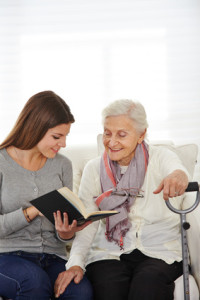
In the almost ten years (!) since I wrote this series of blog posts under the umbrella heading of “reading aloud to the elderly,” there have been many changes in the world. Terminology has changed, so that I’ve found it important to change the word “elderly” to older people, despite the fact that it has been searches for “reading aloud to the elderly” that has brought many people to these posts. The possible ageist implications of “elderly” make it important for me to change this.
Important note: Reading aloud to older people in long-term care or other residential settings is not as easy as walking in, plunking yourself down, and starting to read. There are regulations in place to protect vulnerable older adults that mean there may be background checks or training that you will need to complete to become a regular volunteer. These things are important. Please check with the staff where you would like to volunteer to find out what the requirements are.
This, of course, doesn’t apply to reading aloud to your own family member. I hope it won’t discourage you from doing this oh-so-helpful volunteer work with others, as well.
You may wonder why I think it necessary to address the question of “how” to read aloud to older people, particularly frail older people. Open the book, open your mouth, and read, right?
Well, yes, those are the basics, but there are things you can do to enhance the experience and make it more comfortable for both of you.
Choose your material carefully, with the needs, interests, and cognitive level of the person uppermost in your mind. (Of course, if you’re asked to read a letter they’ve received, or the daily newspaper, just go with it.)
Talk with the person ahead of time. What would they like you to read? As we age, we lose more and more autonomy and freedom of choice, so if they can participate in the selection of reading material that will mean a great deal.
Practice ahead of time. Be sure you can be heard. Most older people have some level of hearing impairment. At the same time, be aware of roommates. They may or may not want to listen in.
With the hearing and roommate issues in mind, sit close to the person you’re reading to. Remember that in closeness there is also a feeling of intimacy and security. Physical closeness can be as important to a lonely person as the sound of your voice reading.
These elements are important for children who want to read to an older person as well.
When talking with the person about selection of reading material, see if they remember their favorite books from their childhood. If the book(s) is/are available (and at the child’s reading level), it can be a great experience for both elder and child to share a book like this.
Practice with the child ahead of time, rehearsing vocal clarity and expression as well as volume. Sometimes it isn’t that they need to shout to be heard, but they need to enunciate their words clearly.
Keep in mind that sometimes high-pitched sounds become harder to hear as people age, so it’s doubly important that children make sure they say their words clearly.
Be open to the older person helping the child with their reading. Some older people would love to be read to — but would also be delighted to encourage the child with the difficult words, and talk with them about what they liked to read when they were young.
Be alert for signs that attention is waning, or the person is tiring. They may even drift off to sleep — this is perfectly okay. Neither the elder nor you need to feel embarrassed about this. It happens. Reading sessions will likely be short. That’s okay, too.
Above all, relax and allow this to be a special time for both of you. Enjoy!

Excellent points Beth!
Thanks, Darlene!
You’ve made some wonderful points, Beth! Thank you!
Great post!